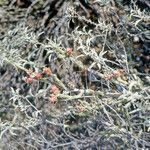Low spreading or erect, sparingly to densely branched shrub, 0.4–1.8 m high, to 4 m diam., large plants forming a central stem. Stem segments alternate, narrow-subcylindric, 2–8 cm long, 3–5.5 mm diam., obscurely tuberculate, glabrous, green or grey-green ,often reddish, terminal segments easily detached; tubercles obscure, only evident at active branch apices, linear, 10–30 mm long, drying as elongate, riblike wrinkles. Areoles apical on tubercles, circular to elliptic or obovate, scarcely raised, filled with white wool, and glochids, ageing grey, 6–9 mm apart. Leaves succulent, linear, terete, or cordiform, tapering to a point, 6.5–9 mm long. Spines absent or 1 (–3) per larger ones per areole, usually in apical areoles to well distributed, straight or arching upward or downward, not obscuring stem, the longer ones 5–15 mm long, c. 0.5 mm wide at base, and often with 1–4 small, erect or spreading weak spines, 1.5–4 mm long, white; spine sheaths loose fitting, dirty creamish to grey. Glochids in an adaxial tuft or crescent to encircling areole, 1.2–2 mm long, white to pale brown. Flowers 10–20 mm diam.; outer tepals green, but margins tinged yellowish; inner tepals pale yellow to greenish yellow, sometimes tipped red, spreading, narrowly obovate or cuneate-obovate, acute, the apex apiculate, 12–20 mm long, 6–9 mm wide. Staminal filaments greenish yellow, creamish at base, anthers yellow. Style yellow; stigma lobes pale yellow or greenish yellow. Pericarpel tuberculate at anthesis, spiny. Fruit solitary or proliferating and forming chains, obovoid to obovoid, the umbilicus usually shallow, 9–20 mm long, 9–10 mm diam., smooth, spineless, glochids often prominent, fleshy at maturity and juicy, orange to red when ripe, indehiscent. Seeds suborbicular to squarish, irregular, 3–4.5 mm diam, often sterile.
More
Shrubs or small trees, sparingly to densely branched, 0.5-1.8 m, usually bearing similar, commonly spineless terminal branchlets arranged at right angles along major axes. Stem segments usually alternate, gray-green or purplish, 2-8 × 0.3-0.5 cm; tubercles linear, drying as elongate, riblike wrinkles, 1.1-2(-3) cm; areoles broadly elliptic, (1-)1.5-3.5 × 0.7-2 mm; wool white to yellow, aging gray. Spines 0-1(-3) per areole, usually in apical areoles to well distributed, erect, flexible, straight or arching upward or downward, red-brown with gray to whitish coat, tips yellow, aging red-brown, terete, angular-flattened basally, the longest (4-)14-45 mm; sheaths gray to purple-gray with yellow to red-brown tips or yellow throughout. Glochids in adaxial tuft or crescent to encircling areole, yellow or reddish brown, 1-3(-5) mm. Flowers: inner tepals pale yellow to greenish yellow, sometimes tipped red, narrowly obovate, 5-8 mm, acute, apiculate; filaments greenish yellow; anthers yellow; style yellow; stigma lobes greenish yellow. Fruits occasionally proliferating, yellow to scarlet (rarely green, sometimes tinged purple, becoming yellow), sometimes stipitate, obovoid, 9-15(-27) × 6-7(-12) mm, fleshy, smooth, spineless; umbilicus 2-4 mm deep; areoles 16-20. Seeds pale yellow, suborbicular to squarish and crenate in outline, warped, 3-4.5 mm diam., sides smooth, each with 1-3 large depressions; girdle smooth or with very narrow ridge. 2n = 22, 33, 44.
Xerophyllous scrub. Deserts, grasslands, chaparrals, oak-juniper woodlands, flats, bajadas and slopes, growing on sandy, loamy to gravelly substrates; at elevations from 40-1,500 metres.
More
Cylindropuntia leptocaulis is an environmental weed, growing in Eucalyptus populnea woodland with scattered shrubs, in grey loamy sands.
It is a subtropical plant.


